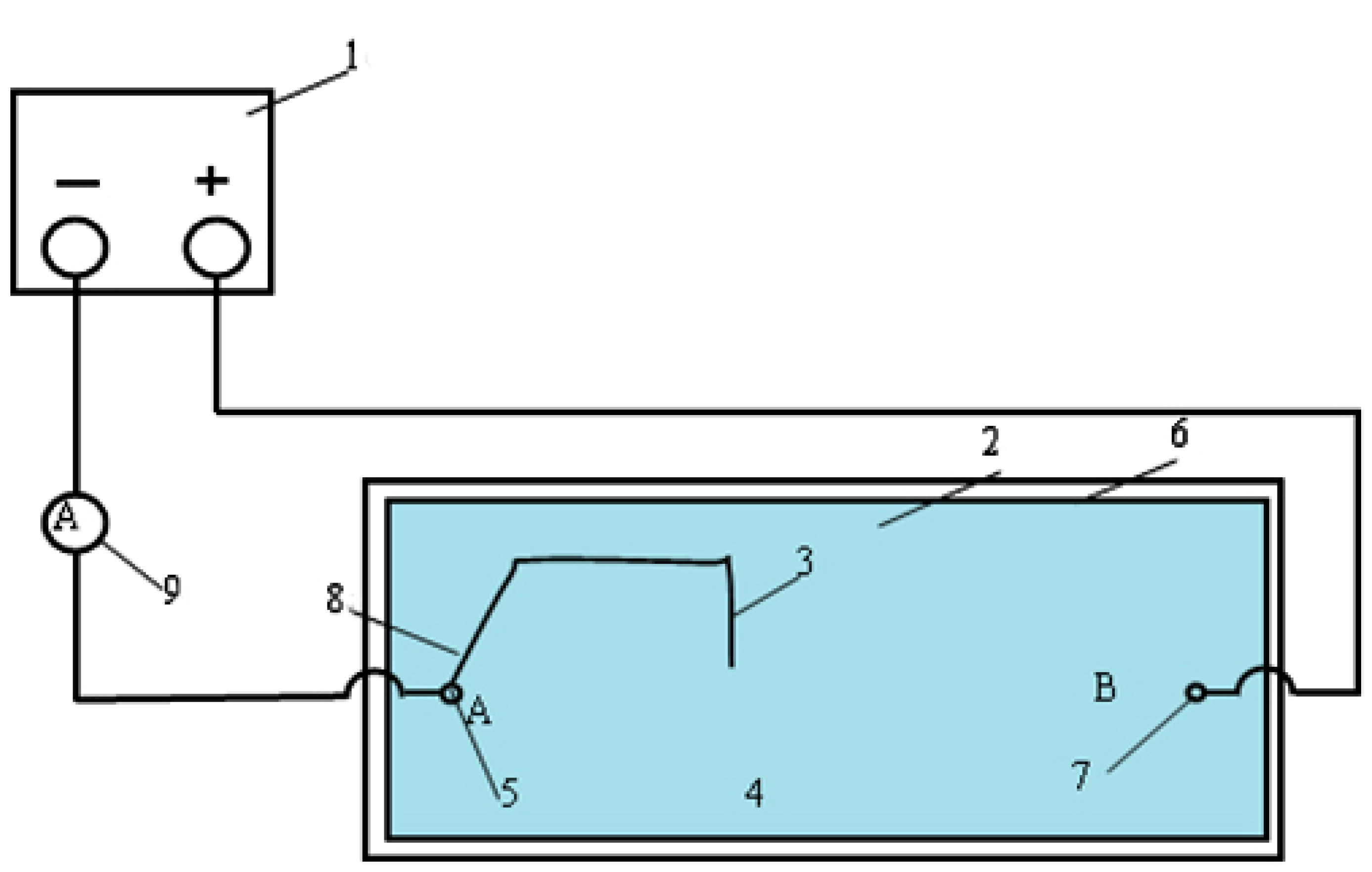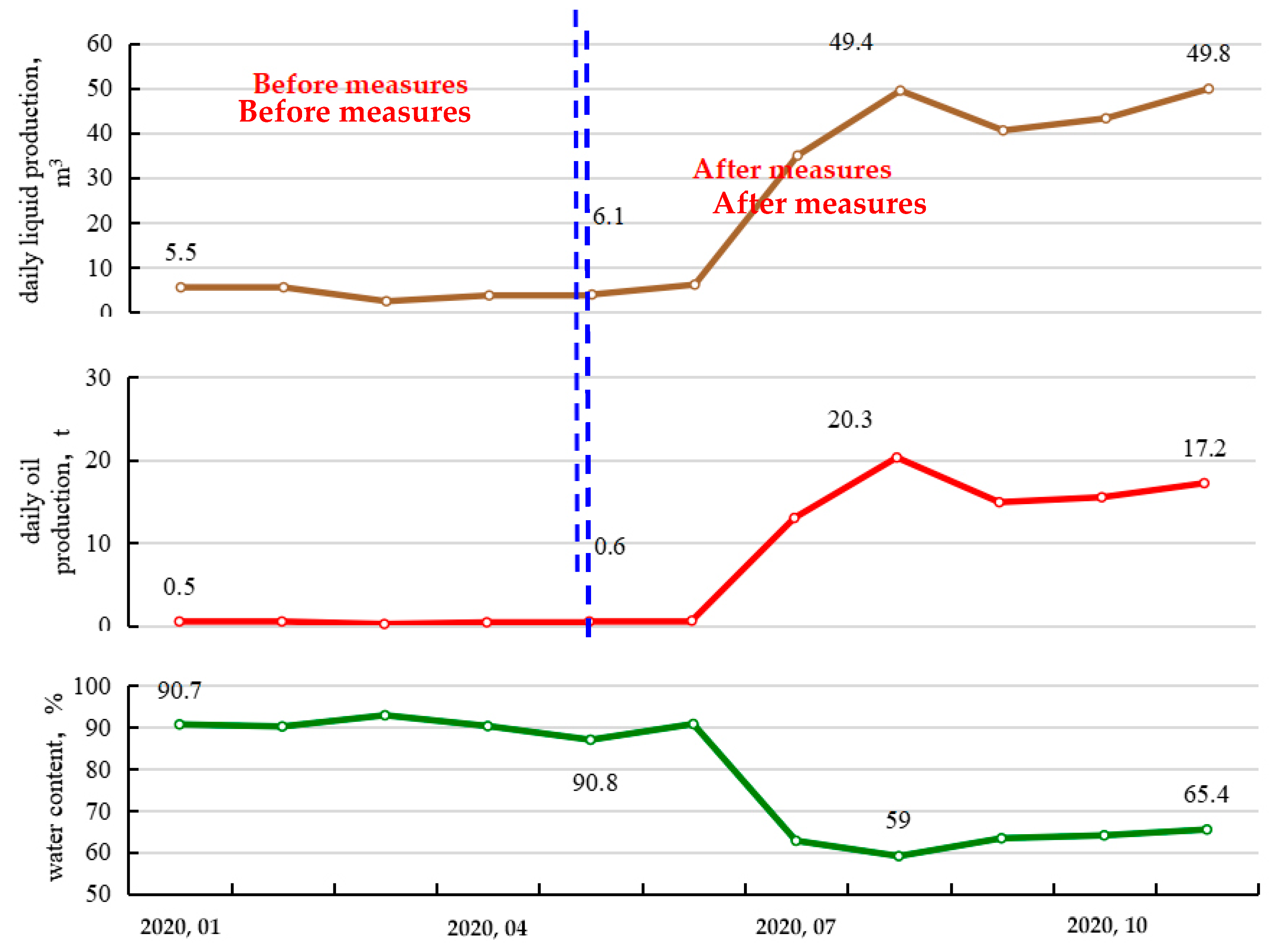Study on Stimulation Mechanism and Parameter Optimization of Radial Water Jet Drilling Technique in Low Physical Property Sections of Petroleum Reservoirs
Abstract
:1. Introduction
2. Experimental Principle
2.1. Hydropower Similarity Principle
2.1.1. Ohm’s Law
- I is current, A;
- is specific resistance, Ω/m;
- is potential gradient (X is generally for area), V/m;
2.1.2. Darcy’s Law
- grad(p), div(V) is gradient and divergence;
- K is permeability, 2;
- is liquid viscosity, mPa∙s.
- R is resistance, Ω;
- is conductor length, m;
- S is wire full section area, m2;
- ρ is resistivity, Ω∙m;
- q is plane single-phase flow liquid flow, m3/d;
- A is sectional area of the plane unidirectional flow core, m2;
- Δp is pressure difference established at both ends of the core, kPa;
- is core length, m;
- μ is liquid viscosity, mPa·s;
- K is formation permeability, μm2;
- 0.0864 is the conversion factor.
2.2. Similarity Relation
2.2.1. Geometric Similarity
- is geometric similarity coefficient;
- are increments in the , , and directions, respectively;
- m and o represent model and oil layer, respectively.
2.2.2. Motion Similarity
- is motion similarity coefficient;
- v is velocity of flow;
- m and o represent model and oil layer, respectively.
2.2.3. Pressure Similarity
- is pressure similarity coefficient;
- is pressure difference between two points in the reservoir, Pa;
- is potential difference between two points of corresponding oil layer in the model, V.
2.2.4. Flow Similarity
- is flow similarity coefficient;
- is current in the model, A;
- is flow in the reservoir, m3/s.
2.2.5. Resistance Similarity
- is resistance similarity coefficient;
- is current flow resistance in the model;
- is fluid-flow resistance in the oil reservoir.
3. Experimental Device and Equipment
3.1. Electrical Analog Device
3.2. Measuring Device Circuit
4. Factors Affecting the Stimulation of Radial Water Jet Drilling in Low Physical Property Section
4.1. Number of Boreholes
- (1)
- Pressure distribution
- (2)
- Current value
4.2. Drilling Angle
- (1)
- Pressure distribution
- (2)
- Current value
4.3. Borehole Length
- (1)
- Pressure distribution
- (2)
- Current value
5. Field Application
6. Conclusions
- (1)
- The length, angle, and number of boreholes are the main factors that affect the yield order and increase the effect. The longer the drilling length, the larger the equivalent radius and the more obvious the stimulation effect. Moreover, radial drilling has an impact on the seepage field, causing changes in its flow line. The pressure inside the drilling hole is lower than the surrounding formation pressure and most flow lines change direction and deviate near the drilling position. The larger the drilling angle, the wider the impact of radial drilling on the reservoir and the better the development effect. However, the interference between the pressure and seepage fields of the two radial drilling holes will also increase with the decrease of the included angle, leading to a worse development effect. The total production capacity will increase as the number of boreholes increases but the increase will be smaller and smaller;
- (2)
- Under constant pressure differential production conditions, when other parameters are the same, with the increase of formation thickness, the production of each radial borehole and the production of vertical wellbore increase. Therefore, when using radial water jet drilling to develop low permeability reservoirs, the formation needs to have a certain thickness so that the development effect can be significantly improved;
- (3)
- Through the analysis of perforation parameters, it can be concluded that the optimal number of boreholes is two, and the optimal borehole length is 100 m when the optimal borehole angle is 180°.
Author Contributions
Funding
Data Availability Statement
Conflicts of Interest
References
- Swartzendruber, D. Non-Darcy flow behavior in liquid-saturated porous media. J. Geophys. Res. 1962, 67, 5205–5213. [Google Scholar] [CrossRef]
- Swartzendruber, D. Non-Darcy Behavior and the Flow of Water in Unsaturated Soils1, 3. Soil Sci. Soc. Am. J. 1963, 27, 491–495. [Google Scholar] [CrossRef]
- Beavers, G.; Sparrow, E. Non-Darcy flow through fibrous porous media. J. Appl. Mech. 1969, 36, 711–714. [Google Scholar] [CrossRef]
- Nasser, M.S. Radial non-Darcy Flow through Porous Media. Master’s Thesis, University of Windsor, Windsor, ON, Canada, 1970. [Google Scholar]
- Basak, P. Non-Darcy flow and its implications to seepage problems. J. Irrig. Drain. Div. 1977, 103, 459–473. [Google Scholar] [CrossRef]
- Cao, G.; Cheng, Q.; Wang, H.; Bu, R.; Zhang, N.; Wang, Q. Percolation Characteristics and Injection Limit of Surfactant Huff-n-Puff in a Reservoir. ACS Omega 2022, 7, 30389–30398. [Google Scholar] [CrossRef] [PubMed]
- McCorquodale, J.A. Finite Element Analysis of Non-Darcy Flow; University of Windsor: Windsor, ON, Canada, 1970. [Google Scholar]
- Volker, R.E. Solutions for unconfined non-Darcy seepage. J. Irrig. Drain. Div. 1975, 101, 53–65. [Google Scholar] [CrossRef]
- Thauvin, F.; Mohanty, K. Network modeling of non-Darcy flow through porous media. Transp. Porous Media 1998, 31, 19–37. [Google Scholar] [CrossRef]
- Zeng, Z.; Grigg, R. A criterion for non-Darcy flow in porous media. Transp. Porous Media 2006, 63, 57–69. [Google Scholar] [CrossRef]
- Huang, H.; Ayoub, J.A. Applicability of the Forchheimer equation for non-Darcy flow in porous media. Soc. Pet. Eng. J. 2008, 13, 112–122. [Google Scholar] [CrossRef]
- Rubin, B. Accurate simulation of non Darcy flow in stimulated fractured shale reservoirs. In Proceedings of the SPE Western Regional Meeting, Anaheim, CA, USA, 27–29 May 2010; Society of Petroleum Engineers: Richardson, TX, USA, 2010. [Google Scholar]
- Guppy, K.; Cinco-Ley, H.; Ramey, H.J., Jr. Effect of non-Darcy flow on the constant-pressure production of fractured wells. Soc. Pet. Eng. J. 1981, 21, 390–400. [Google Scholar] [CrossRef]
- Evans, R.; Hudson, C.; Greenlee, J. The effect of an immobile liquid saturation on the non-Darcy flow coefficient in porous media. SPE Prod. Eng. 1987, 2, 331–338. [Google Scholar] [CrossRef]
- Wang, X.; Thauvin, F.; Mohanty, K. Non-Darcy flow through anisotropic porous media. Chem. Eng. Sci. 1999, 54, 1859–1869. [Google Scholar] [CrossRef]
- Thomas, L.; Katz, D.; Tek, M.R. Threshold pressure phenomena in porous media. Soc. Pet. Eng. J. 1968, 8, 174–184. [Google Scholar] [CrossRef]
- Fuquan, S.; Ciqun, L.; Fanhua, L. Transient pressure of percolation through one dimension porous media with threshold pressure gradient. Appl. Math. Mech. 1999, 20, 27–35. [Google Scholar] [CrossRef]
- Prada, A.; Civan, F. Modification of Darcy’s law for the threshold pressure gradient. J. Pet. Sci. Eng. 1999, 22, 237–240. [Google Scholar] [CrossRef]
- Fuquan, S.; Renjie, J.; Shuli, B. Measurement of threshold pressure gradient of microchannels by static method. Chin. Phys. Lett. 2007, 24, 1995. [Google Scholar] [CrossRef]
- Hao, F.; Cheng, L.S.; Hassan, O.; Hou, J.; Liu, C.Z.; Feng, J.D. Threshold pressure gradient in ultra-low permeability reservoirs. Pet. Sci. Technol. 2008, 26, 1024–1035. [Google Scholar] [CrossRef]
- Dickinson, W.; Dickinson, R.W. Horizontal Radial Drilling System. In Proceedings of the SPE Western Regional Meeting, Bakersfield, CA, USA, 23–25 March 1985. [Google Scholar]
- Dickinson, B.W.O.; Dickinson, R.W.; May, S.C.; Mackey, C.S. Hydraulic Drilling Apparatus and Method. U.S. Patent US4852668, 1 August 1989. [Google Scholar]
- Dickinson, W.; Dykstra, H.; Nees, J.M.; Dickinson, E. The Ultrashort Radius Radial System Applied to Thermal Recovery of Heavy Oil. In Proceedings of the SPE Western Regional Meeting, Bakersfield, CA, USA, 30 March–1 April 1992. [Google Scholar]
- Ragab, A.M.S. Radial Drilling Technique for Improving Well Productivity in Petrobel-Egypt. In Proceedings of the North Africa Technical Conference & Exhibition, Cairo, Egypt, 15–17 April 2013. [Google Scholar]
- Bruni, M.; Biasotti, J.; Salomone, G. Radial Drilling in Argentina. In Proceedings of the Latin American & Caribbean Petroleum Engineering Conference, Buenos Aires, Argentina, 15–18 April 2007. [Google Scholar]
- Wall, G. Technologies to Develop Mature Oil Fields. In Proceedings of the Uzbekistan International Oil & Gas Exhibition and Conference, Tashkent, Uzbekistan, 14–16 May 2011. [Google Scholar]
- Chen, Y.; Ding, Y.; Liang, C.; Zhu, D.; Bai, Y.; Zou, C. Initiation mechanisms of radial drilling—Fracturing considering shale hydration and reservoir dip. Energy Sci. Eng. 2021, 9, 113981. [Google Scholar] [CrossRef]










Disclaimer/Publisher’s Note: The statements, opinions and data contained in all publications are solely those of the individual author(s) and contributor(s) and not of MDPI and/or the editor(s). MDPI and/or the editor(s) disclaim responsibility for any injury to people or property resulting from any ideas, methods, instructions or products referred to in the content. |
© 2023 by the authors. Licensee MDPI, Basel, Switzerland. This article is an open access article distributed under the terms and conditions of the Creative Commons Attribution (CC BY) license (https://creativecommons.org/licenses/by/4.0/).
Share and Cite
Cao, G.; Yi, X.; Zhang, N.; Li, D.; Xing, P.; Liu, Y.; Zhai, S. Study on Stimulation Mechanism and Parameter Optimization of Radial Water Jet Drilling Technique in Low Physical Property Sections of Petroleum Reservoirs. Processes 2023, 11, 2029. https://doi.org/10.3390/pr11072029
Cao G, Yi X, Zhang N, Li D, Xing P, Liu Y, Zhai S. Study on Stimulation Mechanism and Parameter Optimization of Radial Water Jet Drilling Technique in Low Physical Property Sections of Petroleum Reservoirs. Processes. 2023; 11(7):2029. https://doi.org/10.3390/pr11072029
Chicago/Turabian StyleCao, Guangsheng, Xi Yi, Ning Zhang, Dan Li, Peidong Xing, Ying Liu, and Shengbo Zhai. 2023. "Study on Stimulation Mechanism and Parameter Optimization of Radial Water Jet Drilling Technique in Low Physical Property Sections of Petroleum Reservoirs" Processes 11, no. 7: 2029. https://doi.org/10.3390/pr11072029
APA StyleCao, G., Yi, X., Zhang, N., Li, D., Xing, P., Liu, Y., & Zhai, S. (2023). Study on Stimulation Mechanism and Parameter Optimization of Radial Water Jet Drilling Technique in Low Physical Property Sections of Petroleum Reservoirs. Processes, 11(7), 2029. https://doi.org/10.3390/pr11072029






